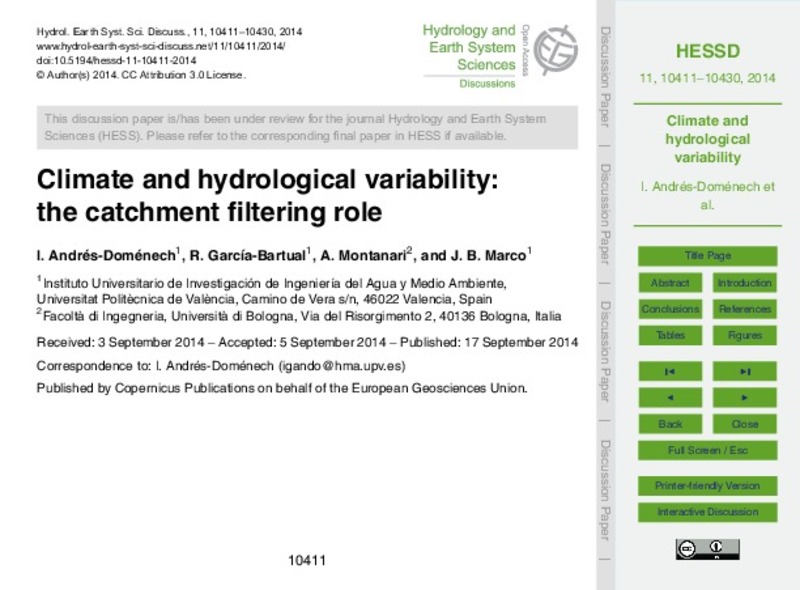JavaScript is disabled for your browser. Some features of this site may not work without it.
Buscar en RiuNet
Listar
Mi cuenta
Estadísticas
Ayuda RiuNet
Admin. UPV
Climate and hydrological variability: the catchment filtering role
Mostrar el registro sencillo del ítem
Ficheros en el ítem
| dc.contributor.author | Andrés Doménech, Ignacio
|
es_ES |
| dc.contributor.author | García Bartual, Rafael Luis
|
es_ES |
| dc.contributor.author | Montanari, Alberto
|
es_ES |
| dc.contributor.author | Marco Segura, Juan Bautista
|
es_ES |
| dc.date.accessioned | 2015-09-25T12:33:05Z | |
| dc.date.available | 2015-09-25T12:33:05Z | |
| dc.date.issued | 2015 | |
| dc.identifier.issn | 1812-2108 | |
| dc.identifier.uri | http://hdl.handle.net/10251/55124 | |
| dc.description.abstract | Measuring the impact of climate change on flood frequency is a complex and controversial task. Identifying hydrological changes is difficult given the factors, other than climate variability, which lead to significant variations in runoff series. The catchment filtering role is often overlooked and thus may hinder the correct identification of climate variability signatures on hydrological processes. Does climate variability necessarily imply hydrological variability? This research aims to analytically derive the flood frequency distribution based on realistic hypotheses about the rainfall process and the rainfall-runoff transformation. The annual maximum peak flow probability distribution is analytically derived to quantify the filtering effect of the rainfall-runoff process on climate change. A sensitivity analysis is performed according to typical semi-arid Mediterranean climatic and hydrological conditions, assuming a simple but common scheme for the rainfall-runoff transformation in small-size ungauged catchments, i.e. the CN-SCS model. Variability in annual maximum peak flows and its statistical significance are analysed when changes in the climatic input are introduced. Results show that depending on changes in the annual number of rainfall events, the catchment filtering role is particularly significant, especially when the event rainfall volume distribution is not strongly skewed. Results largely depend on the return period: for large return periods, peak flow variability is significantly affected by the climatic input, while for lower return periods, infiltration processes smooth out the impact of climate change. | es_ES |
| dc.language | Inglés | es_ES |
| dc.publisher | European Geosciences Union (EGU) | es_ES |
| dc.relation.ispartof | Hydrology and Earth System Sciences Discussions | es_ES |
| dc.rights | Reconocimiento (by) | es_ES |
| dc.subject | GENERALIZED PARETO DISTRIBUTION | es_ES |
| dc.subject | FRESH-WATER RESOURCES | es_ES |
| dc.subject | FLOOD FREQUENCY | es_ES |
| dc.subject | PARAMETER-ESTIMATION | es_ES |
| dc.subject | STOCHASTIC RAINFALL | es_ES |
| dc.subject | DISTRIBUTIONS | es_ES |
| dc.subject | DURATION | es_ES |
| dc.subject | PROBABILITY | es_ES |
| dc.subject | THRESHOLDS | es_ES |
| dc.subject.classification | INGENIERIA HIDRAULICA | es_ES |
| dc.title | Climate and hydrological variability: the catchment filtering role | es_ES |
| dc.type | Artículo | es_ES |
| dc.identifier.doi | 10.5194/hessd-11-10411-2014 | |
| dc.rights.accessRights | Abierto | es_ES |
| dc.contributor.affiliation | Universitat Politècnica de València. Departamento de Ingeniería Hidráulica y Medio Ambiente - Departament d'Enginyeria Hidràulica i Medi Ambient | es_ES |
| dc.description.bibliographicCitation | Andrés Doménech, I.; García Bartual, RL.; Montanari, A.; Marco Segura, JB. (2015). Climate and hydrological variability: the catchment filtering role. Hydrology and Earth System Sciences Discussions. 19(1):379-387. doi:10.5194/hess-19-379-2015 | es_ES |
| dc.description.accrualMethod | S | es_ES |
| dc.relation.publisherversion | http://dx.doi.org/10.5194/hessd-11-10411-2014 | |
| dc.description.upvformatpinicio | 379 | es_ES |
| dc.description.upvformatpfin | 387 | es_ES |
| dc.type.version | info:eu-repo/semantics/publishedVersion | es_ES |
| dc.description.volume | 19 | es_ES |
| dc.description.issue | 1 | es_ES |
| dc.relation.senia | 284793 | es_ES |








